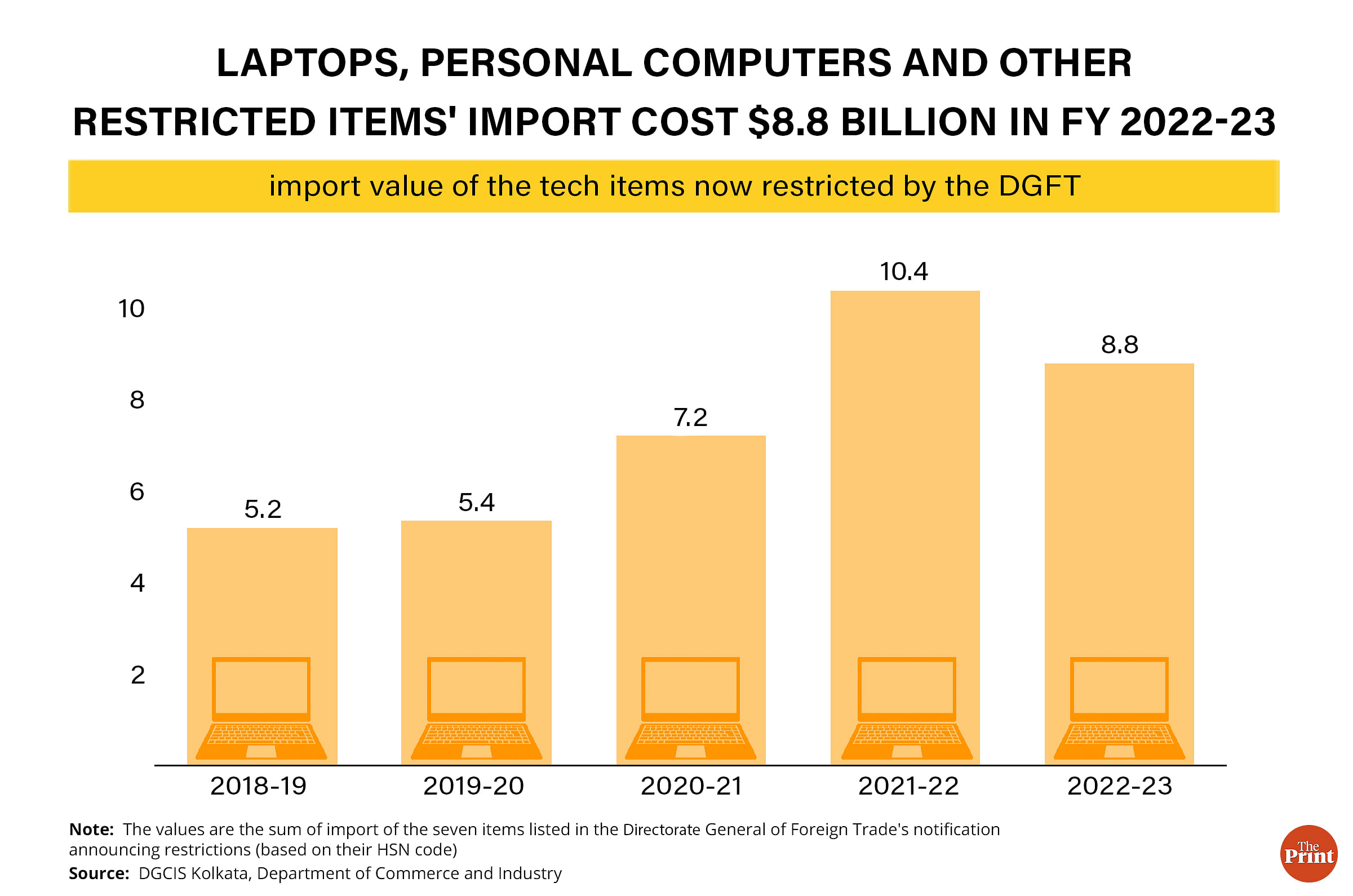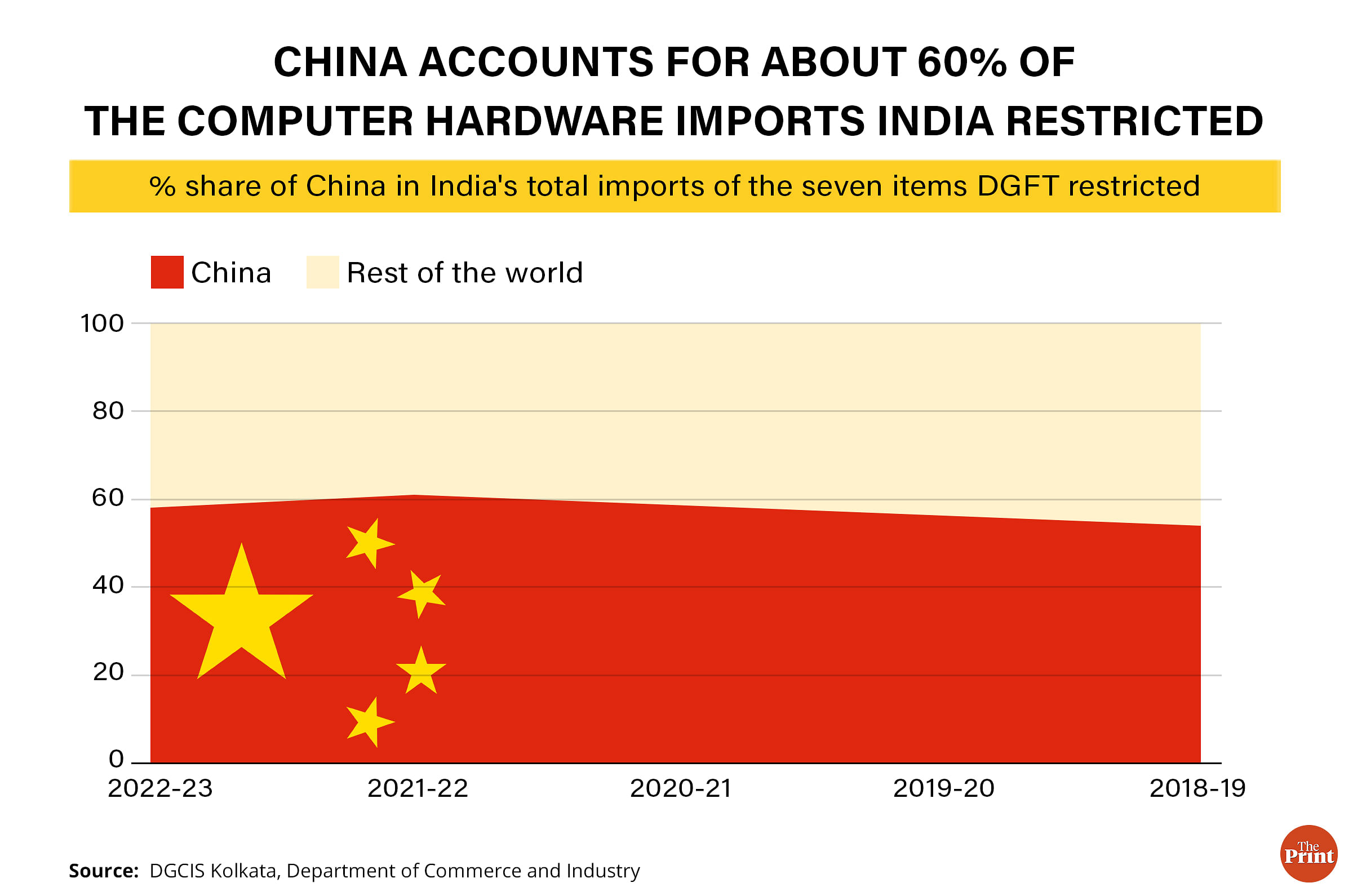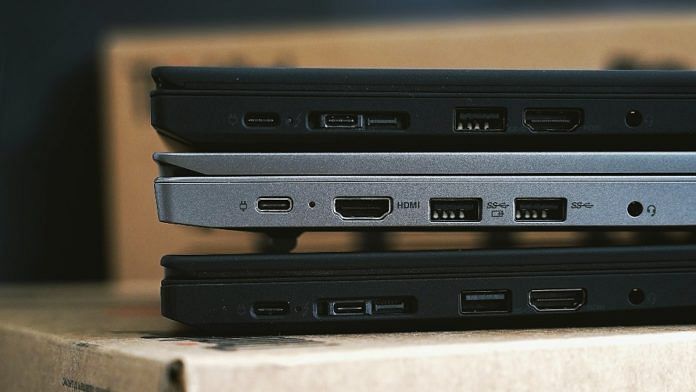New Delhi: The government’s move to restrict the import of laptops, personal computers, and tablets with immediate effect is aimed at boosting local manufacturing and creating a trusted supply chain, and may have been prompted by a “genuine apprehension of a future security risk”. Experts believe the move could have also been intended to encourage importers to acquire specific licences but may lead to a supply crunch and price fluctuations in the short run, especially ahead of the upcoming festive season.
“Import of laptops, tablets, all-in-one personal computers, and ultra small form factor computers and servers falling under HSN 8741 shall be ‘restricted’,” read the notification issued Thursday by the Directorate General of Foreign Trade (DGFT), an attached office of the Ministry of Commerce and Industry.
Imports would be allowed for those with a valid licence for restricted imports, the notification said, adding that the restriction would not apply to passengers carrying these devices in their baggage or on the import of “one laptop, tablet, all-in-one personal computer or ultra small form factor computer, including those purchased from e-commerce portals through post or courier”.
The Print reached DGFT via phone and email for comment on what prompted the decision and whether it expected pushback from other countries, but had not received a response by the time of publication. This report will be updated if and when a response is received.
According to government sources, the notification was announced “keeping in view that some of the hardware could potentially have security-related issues that could compromise sensitive and personal data”.
India needs to source from “trusted and reliable” partners, keeping in mind the digital safety of citizens, sources said, adding that the government has also taken note of the fact that “India has a huge IT services sector and the government has also encouraged manufacturing in India and a lot of multinationals have already set up manufacturing bases in India”.
Asked if a security breach or a particular incident triggered the notification from DGFT, sources said, “There was no particular incident but a genuine apprehension of a future security risk.”
Multiple brands including Dell Technologies, Acer, HP and Apple sell laptops, tablets and PCs in India. On Monday, Reliance Retail, the latest entrant to the market, launched its ‘JioBook’, priced at Rs 16,499.
Also Read: Govt detected Rs 9,075 cr tax evasion by Chinese mobile makers, has recovered only 18% so far
‘Timing could’ve been better’
Sector experts believe that though abrupt, the move is not surprising given the government’s push in favour of domestic manufacturers. At the same time, they believe that its timing could’ve been better.
“The move isn’t surprising as the government has been trying to push local electronic manufacturing,” Tarun Pathak, research director at research firm Counterpoint Technology, told ThePrint.
He added that the government last week announced its decision to extend the application window under the Production-linked incentive (PLI) scheme 2.0 for IT hardware. “This notification could be aimed at making PLI 2.0 a success, as the PLI 1.0 did not receive a very good response from the industry,” said Pathak.
He also pointed out that the revised policy offers a better incentive of about 5 percent on net incremental sales versus about 2 percent in the earlier scheme, and that among all the PLI schemes introduced by the government, IT hardware was the only one to have received a muted response.
Pathak further said that India has achieved almost 100 percent local manufacturing (assembly) of products in smartphones and TVs, and about 50-55 percent for wearables. However, IT hardware has been lagging behind with only 30-35 percent of those products being made in India.
Bharath Shenoy — senior market analyst at tech media, data and marketing services company International Data Corporation (IDC) — agreed with this assessment, saying that the government aims to encourage local manufacturing and assembly. He, however, expressed some concerns.
“Our ecosystem isn’t ready yet for assembly of this magnitude,” he said adding that “vendors ship in close to 2 million notebooks every quarter with around three-fourths out of this imported”. Shenoy further underlined that “almost the entire volume of premium notebooks is imported”.
He added that the timing of the move may not be ideal since the PC market in India has been struggling for the last two-three quarters and such a move could further dampen the market sentiment.
“So yes, the intent is right as it aims to give a push to local assembly, which will eventually help in building the ecosystem and might also lead to exports,” he said. “However, the timing could have been better.”
Bulk of imports from China
ThePrint scanned import data from the Ministry of Commerce and Industry of the seven items that have been restricted and found that India imported $8.79 billion worth of these in the financial year ending March 2023 — almost 15 percent less than the previous year’s value of $10.38 billion.

On average, India imported about $7.3 billion of such goods each year since 2018-19.
Country-wise data analysis shows that in 2022-23, China accounted for about 58 percent of India’s total import of these seven IT hardware products in FY 2022-23. That is, of the total import of these items worth $8.79 billion during this period, items worth more than $5.1 billion were imported from China and items worth $3.67 billion from the rest of the world.

Five years ago, in 2018-19, China accounted for about 54 percent of these items. This number rose to 61 percent by 2021-22 before declining marginally by 2022-23.
Also Read: Flexible batteries to sensors your plants can ‘wear’ — WEF’s top 10 emerging technologies for 2023
Festive season & short-term consumer impact
Pathak added that this move could disrupt supply in the short term for all brands, especially as this order comes ahead of the festive season, which is a strong sales period. The festive season, which lasts for just a month or so, usually accounts for about 20 percent of the industry’s annual sales.
According to Pathak, the industry may have anticipated this move from the government as it witnessed a dip in local manufacturing in the first half of this year. “In 2022, about 40 per cent of laptops (sold in India) were made in India; this dipped to around 30 per cent in the first half of the year, so it is likely that brands anticipated this and stocked up,” he explained.
Another view among experts is that a major factor prompting this notification was to encourage importers to acquire the specific licences from the government that would enable them to import these goods.
Prabhu Ram, head of Industry Intelligence Group (IIG) at market research firm CyberMedia Research (CMR), said that Thursday’s policy announcement intends to accelerate PLI 2.0 by limiting specific electronics imports and enforcing licences for restricted items, besides fostering domestic production and self-reliance in the IT hardware sector.
He added that while it is too early to speculate on the comprehensive ramifications of this announcement, consumers could potentially encounter reduced product availability, as well as fluctuations in price as the market adjusts to the implications of the new policy.
Pankaj Mohindroo, chairman at industry body India Cellular & Electronics Association (ICEA), said the announcement seems to be based on the premise of providing secure digital access to the burgeoning number of digital citizens. “We are confident that valid licences will be provided to trusted industry partners, which will enable Ease of Doing Business (EoDB) and unrestricted access to trusted brands for digital consumers,” he said.
Boost to domestic manufacturing
Last week, the government extended the window for receiving applications under PLI Scheme 2.0 for IT Hardware up to 30 August, 2023.
The scheme, with a budgetary outlay of Rs 17,000 crore, was approved by the Union Cabinet on 17 May, 2023, with the objective of enhancing India’s manufacturing capabilities.
According to an official release, the scheme is expected to lead to total production of IT hardware of about Rs 3.35 lakh crore, bring an additional investment of Rs 2,430 crore in electronics manufacturing, and lead to the generation of 75,000 additional direct jobs.
“The scheme will promote large-scale manufacturing in laptops, tablets, all-in-one PCs, servers and ultra small form factor (USFF) devices and contribute significantly to achieve electronics manufacturing turnover of approximately USD 300 billion by 2025-26,” the release said.
With inputs from Pia Krishnankutty
(Edited by Amrtansh Arora)
Also Read: No, Netflix won’t be more expensive because of Modi govt’s new foreign transaction rules. Here’s why



